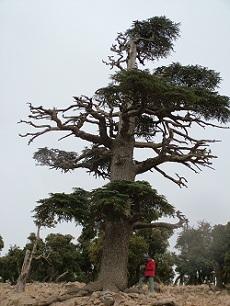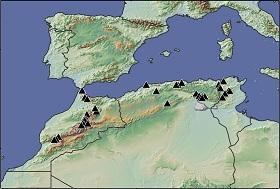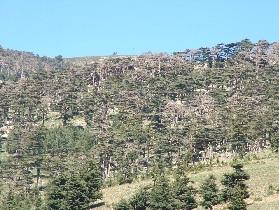Using AI to control energy for indoor agriculture
30 September 2024
Published online 12 June 2010

In an effort to learn more about the future of the climate in northwestern Africa, a team of researchers looks to rings in ancient trees to recreate a climatic history spanning several centuries.
The research, published in the Climate Dynamics journal1, is the first multi-century reconstruction of droughts in Morocco, Algeria and Tunisia. It shows that the region suffered severe and persistent droughts during the thirteenth and sixteenth centuries. The droughts decreased over the following 400 years. However, the same pattern of severe droughts returned in the twentieth century.
"One of the most important ways to understand the climate variability is to use the proxy record, and one of the most reliable proxy records is tree rings," said lead researcher Ramzi Touchan from the University of Arizona, United States.
"Our research is based on the science of dendrochronology. The term 'dendro' is from 'dendron', the Greek word for tree, and 'chronology' means the assignment of dates to particular events in a time series," he explained.
To increase the accuracy of the results, the team used special instruments that can measure the ring sizes with a precision up to 0.01 mm. "Tree ring records are 100% reliable in dating climate events because each annual ring is dated to the exact calendar year," added Touchan.
The three countries studied are mainly covered by the Sahara desert, the world's largest hot desert, which is nearly the size of Europe. Water plays a pivotal role in this area of the world, which is one of the most endangered regions due to climate change. "This is the first regional climate reconstruction that can be used by water resource managers," said Touchan.

Ramzi Touchan
In spite of the challenge, climate research in the Middle East is still in its infancy.
"This region has not really assessed what will be the impacts of climate change," said Mahendra Shah, who is the director of the Qatar National Food Security Programme. "By looking at the global climate-change models it is obvious that these areas will get hotter than other areas in the world and what little precipitate we have will be further reduced."
According to Touchan, recent drying trends in their drought reconstruction are consistent with some general climate models that show man-made effects on climate change in subtropical regions. "But the long-term record has other droughts that could not have been caused by man. We cannot say our results prove that the current drought is anthropogenic in origin."
The researchers gathered samples from trees at 39 different sites in the three countries. Each site yielded at least 20 trees. By looking at various characteristics of the tree rings from these samples, the researchers can give an accurate picture of what the climate was like hundreds of years ago. The trees sampled go back as far as the year 883.
"The history of changes in the trees' environment may be reconstructed using various properties of annual tree rings, such as their width, cell sizes, wood density, trace-element composition, and radioactive and stable isotope ratios," said Touchan.
The width of the annual growth rings in trees in semi-arid environments is highly correlated with the amount of precipitation, added David Meko, who is an associate research professor at the University of Arizona and co-author of the paper.
By analysing these different factors, the researchers can capture a screen shot of what the climate looked like in any year in the past. Touchan explained that this is especially useful because in most of North Africa, weather information has been recorded only for the past 50 years or so, which is too short a period to provide the long-term understanding needed for resource planning.
The data gathered show that, over the centuries, drought in Morocco was associated with El Niño events and a warming of the Indian Ocean. However, drought in Algeria and Tunisia was driven by a warm tropical Atlantic Ocean.
"Moreover, the North Atlantic oscillation was found to have strong negative correlation with the reconstructed index of drought in Morocco, but weak or no correlations with the drought indices in Algeria and Tunisia," added Touchan. This suggests that different mechanisms were driving drought in both regions.

Ramzi Touchan
The team included local researchers from the National School of Forest Engineering in Morocco, the Institute of Sylvo-Pastoral of Tabarka in Tunisia and the Department of Agronomy of the University of Ouargla in Algeria.
The US National Science Foundation, which funded the research, will fund Touchan and Meko to continue their research in Lebanon, Greece, Turkey and Cyprus. They will gather historic drought reconstructions made using tree rings, much like in their current research. Using both sets of data, they want to study patterns of large-scale climate variations influencing the Middle East and identify the relationships among regional droughts, radiative forcing and atmosphere–ocean dynamics.
They also want to apply for additional funding to continue further research in North Africa, expanding to Libya. They hope to create a complete map of reconstructed drought-related climate variables over North Africa, covering hundreds of years, and to apply the reconstructions in climatological analysis.
"The drought reconstructions that we will develop will contribute to a North Africa drought atlas compatible with similar atlases now existing, or being developed, for other parts of the Northern Hemisphere," said Touchan.
"Drought patterns will also be placed in context of climate-change projections from general circulation models (GCMs)."
doi:10.1038/nmiddleeast.2010.162
Stay connected: